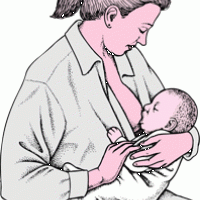Breastfeeding
Introduction
A normal newborn has active rooting and sucking reflexes and can start feeding right away, so doctors recommend placing the newborn at the mother's breast immediately after birth. If this is not done, feedings are begun at least within 4 hours after birth.
recommend placing the newborn at the mother's breast immediately after birth. If this is not done, feedings are begun at least within 4 hours after birth.
Most babies swallow air along with their milk. Babies usually cannot burp on their own, so a parent needs to help. Babies should be held upright, leaning against the parent's chest, with their head against the parent's shoulder, while the parent pats them gently on their back. The combination of patting and pressure against the shoulder usually leads to an audible burp, often accompanied by spitting up of a small amount of milk.
Although babies may be fed breast milk or formula, doctors recommend exclusive breastfeeding for at least the first 6 months. However, breastfeeding is not always possible (for example, if the mother is taking certain drugs), and many healthy babies have been raised on formula feedings.
Benefits of Breastfeeding
Breast milk is the ideal food for newborns. Besides providing the necessary nutrients in the most easily digestible and absorbable form, breast milk contains antibodies and white blood cells that protect the baby against infection. Breast milk favorably changes the pH of the stool and intestinal flora, thus protecting the baby against bacterial diarrhea. Because of the protective qualities of breast milk, many types of infections occur less often in babies who are breastfed rather than bottle-fed. Breastfeeding also seems to protect against the development of certain chronic problems, such as allergies, diabetes, celiac sprue, and Crohn's disease.
Breastfeeding offers many advantages to the mother as well. For example, it helps her to bond and feel close to her baby in a way that bottle-feeding cannot. Mothers who breastfeed have a quicker recovery time after delivery and have some long-term health benefits, such as decreased risk of obesity, osteoporosis, breast cancer, and ovarian cancer. About 60% of mothers in the United States breastfeed their babies, and this proportion is steadily increasing. Mothers who work may breastfeed while at home and have the baby bottle-feed pumped breast milk or formula during the hours they are away. Most doctors recommend giving daily vitamin D supplements to breastfed infants after 2 months of age.
A thin yellow fluid, called colostrum, flows from the nipple before breast milk is produced. Colostrum is rich in calories, protein, and antibodies. The antibodies are absorbed directly into the body from the stomach, protecting the baby against many infections.
Positioning a Baby to Breastfeed
The mother settles into a comfortable, relaxed position. She may sit or lie almost flat, and she may hold the baby in several different positions.  A mother should find the position that works best for her and her baby. She may wish to alternate among different positions.
A mother should find the position that works best for her and her baby. She may wish to alternate among different positions.
A common position is holding the baby on the lap so that the baby is facing the mother, stomach to stomach. The mother supports the baby's neck and head with her left arm when the baby is feeding on the left breast. The baby is brought to the level of the breast, not the breast to the baby. Support for the mother and the baby is important. Pillows can be placed behind the mother's back or under her arm. Placing her feet on a footstool or coffee table may help keep her from leaning over the baby. Leaning over may strain her back and result in a poor latch. A pillow or folded blanket may be placed under the baby for added support.
Breastfeeding Procedure
To begin breastfeeding, the mother settles into a comfortable, relaxed position, either seated or lying almost flat, and turns from one side to the other to offer each breast. The baby faces the mother. The mother supports her breast with her thumb and index finger on top and other fingers below and brushes her nipple against the middle of the baby's lower lip, which stimulates the baby's mouth to open (the rooting reflex) and grasp the breast. As the mother eases the nipple and areola into the baby's mouth, she makes sure the nipple is centered, which helps keep the nipple from becoming sore. Before removing the baby from the breast, the mother breaks the suction by inserting her finger into the baby's mouth and gently pressing the baby's chin down. Sore nipples result from poor positioning and are easier to prevent than to cure.
Initially, the baby tends to feed for several minutes at each breast. The resulting reflex (let-down reflex) in the mother triggers milk production. The production of milk depends on sufficient suckling time, so feeding times should be long enough for milk production to be fully established. During the first few weeks, the infant should be encouraged to nurse on both breasts with each feeding; however, some infants fall asleep while feeding at the first breast. The breast used last should be used first for the next feeding. For a first baby, full milk production is usually established in 72 to 96 hours. Less time is needed for subsequent babies. If the mother is particularly tired during the first night, one middle-of-the-night feeding may be replaced with water, but only after consulting the doctor. However, no more than 6 hours should elapse between feeding sessions during the first few days in order to stimulate breast milk production. Feeding should be on demand (the baby's, that is) rather than by the clock. Similarly, the length of each breastfeeding session should be adjusted to meet the baby's needs. Babies nurse 8 to 12 times in a 24-hour period, but this guideline varies widely.
The mother should take the baby, especially a first baby, to the doctor 3 to 5 days after delivery so that the doctor can find out how breastfeeding is going, weigh the baby, and answer any questions. A doctor may need to see the baby earlier if the baby was discharged within 24 hours, is not feeding well, or if the parents have a particular concern. Because mothers cannot tell exactly how much milk a baby takes, doctors use frequency of feeding and weight gain to tell whether milk production is adequate. Babies that are hungry and feed every hour or two but fail to gain weight appropriately for their age and size are probably not getting enough milk.
Weaning
When to stop breastfeeding (wean the infant) depends on the needs and desires of both mother and baby. The most desirable feeding combination is to breastfeed exclusively for at least 6 months, breastfeed along with solid foods until age 12 months, and then continue to breastfeed for as long as mother and child wish. Gradual weaning over weeks or months is easier for both the baby and mother than stopping suddenly. Mothers initially replace one to three breastfeeding sessions a day with a bottle or cup of fruit juice (fruit juice should not be used when weaning infants younger than 6 months old), expressed breast milk, or formula. Some feedings, particularly those at mealtimes, should be replaced with solid food. Learning to drink from a cup is an important developmental milestone, and weaning to a cup can be completed by age 10 months. Mothers gradually replace more and more breastfeedings, although many infants continue one or two breastfeedings daily until the age of 18 to 24 months or longer. When breastfeeding continues longer, the child should also be eating solid foods and drinking from a cup.
From The Merck Manual of Medical Information – Second Home Edition, edited by Mark H. Beers. Copyright 2003 by Merck & Co., Inc., Whitehouse Station, NJ. See http://www.merck.com/mmhe/sec23/ch263/ch263e.html#sec23-ch263-ch263e-33 for full article. Accessed 3 July 2008. Please visit all of The Merck Manuals free online at www.MerckManuals.com.



